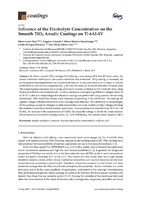Influence of the electrolyte concentration on the smooth TiO2 anodic coatings on Ti-6Al-4V

Date
2017-03-03Author
Vera, María Laura
Colaccio, Ángeles
Rosenberger, Mario Roberto
Schvezov, Carlos Enrique
Ares, Alicia Esther
Metadata
Show full item recordAbstract
To obtain smooth TiO2 coatings for building a new design of Ti-6Al-4V heart valve, the anodic oxidation technique in pre-spark conditions was evaluated. TiO2 coating is necessary for its recognized biocompatibility and corrosion resistance. A required feature on surfaces in contact with blood is a low level of roughness (Ra ≤ 50 nm) that does not favor the formation of blood clots. The present paper compares the coatings obtained by anodic oxidation of the Ti-6Al-4V alloy using H2SO4 at different concentrations (0.1?4 M) as electrolyte and applying different voltages (from 20 to 70 V). Color and morphological analysis of coatings are performed using optical and scanning microscopy. The crystalline phases were analyzed by glancing X-ray diffraction. By varying the applied voltage, different interference colors coatings were obtained. The differences in morphologies of the coatings caused by changes in acid concentration are more evident at high voltages, limiting the oxidation conditions for the desired application. Anatase phase was detected from 70 V for 1 M H2SO4. An increase in the concentration of H2SO4 decreases the voltage at which the transformation of amorphous to crystalline coatings occurs; i.e., with 4 M H2SO4, the anatase phase appears at 60 V.
Collections
The following license files are associated with this item:



